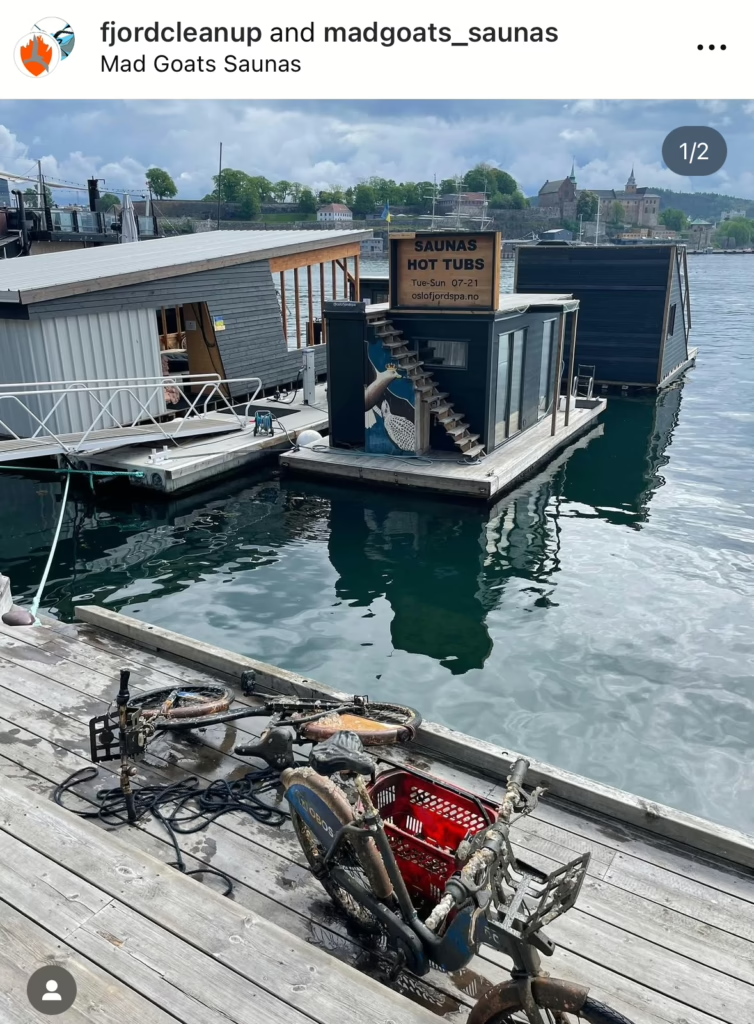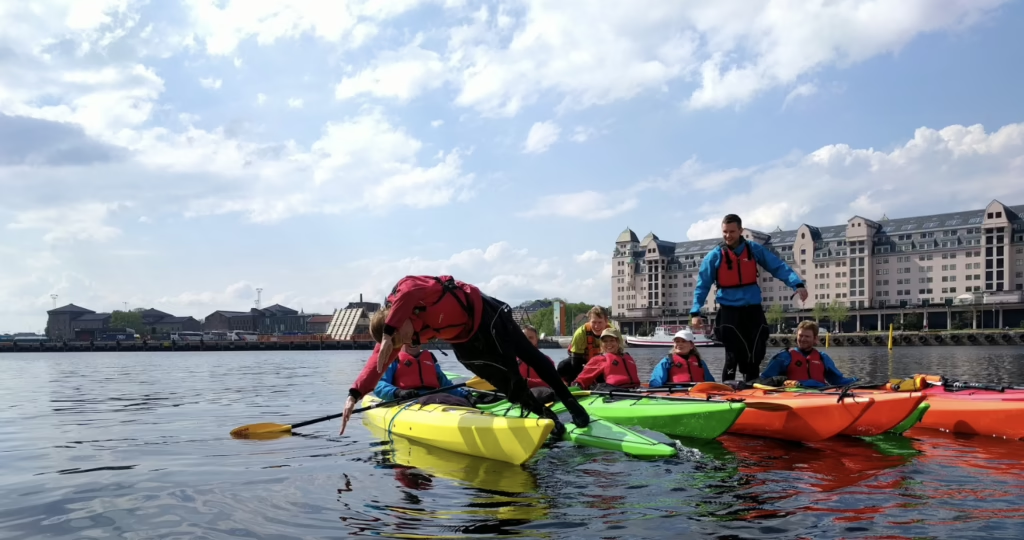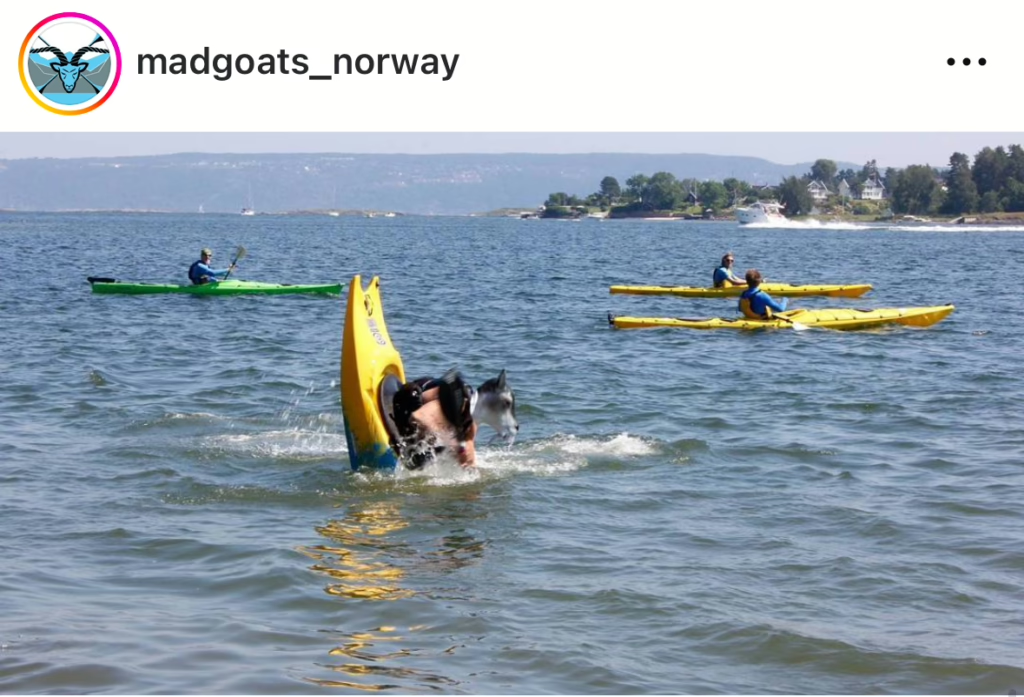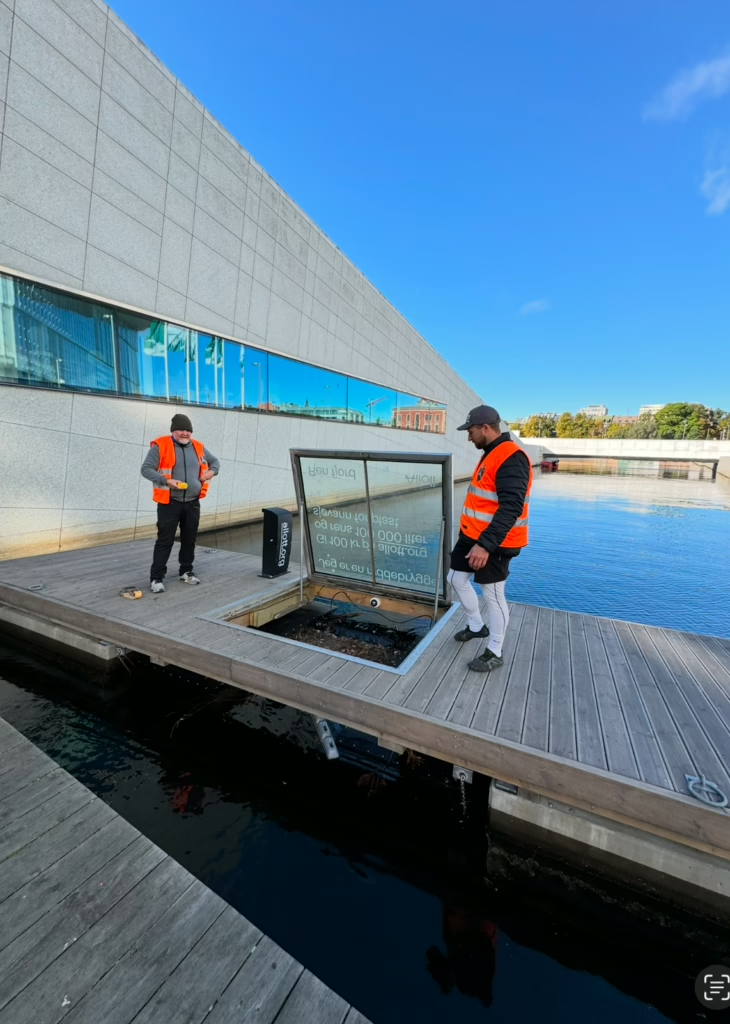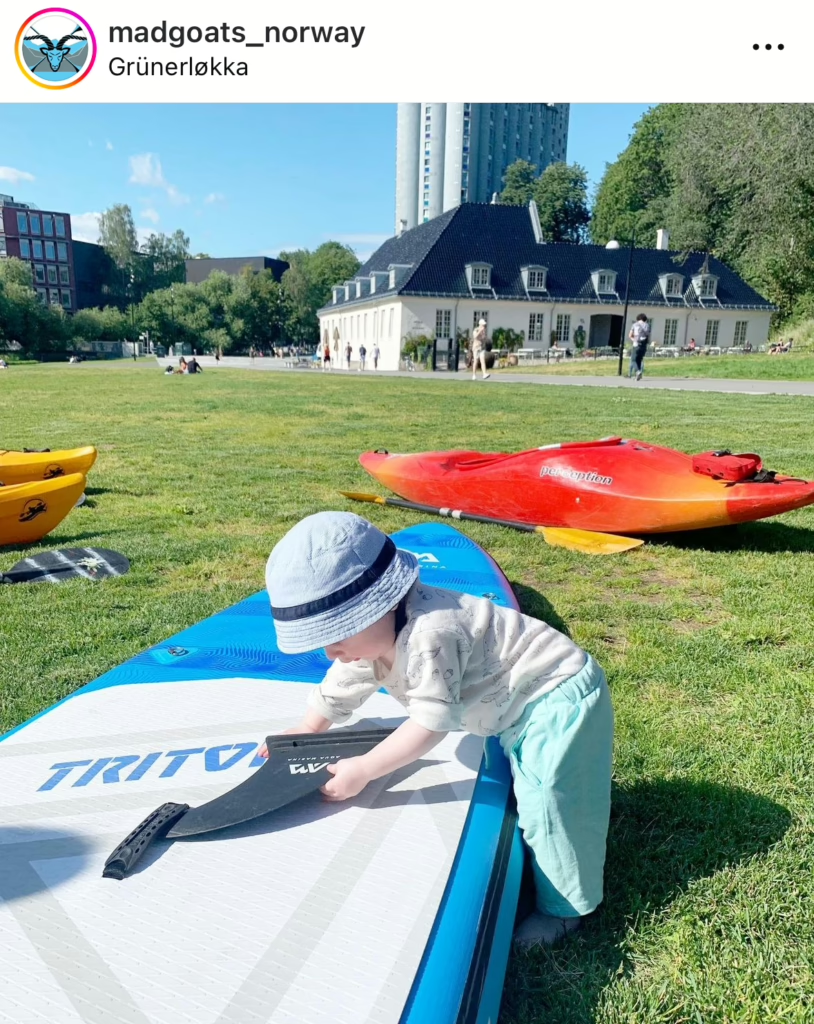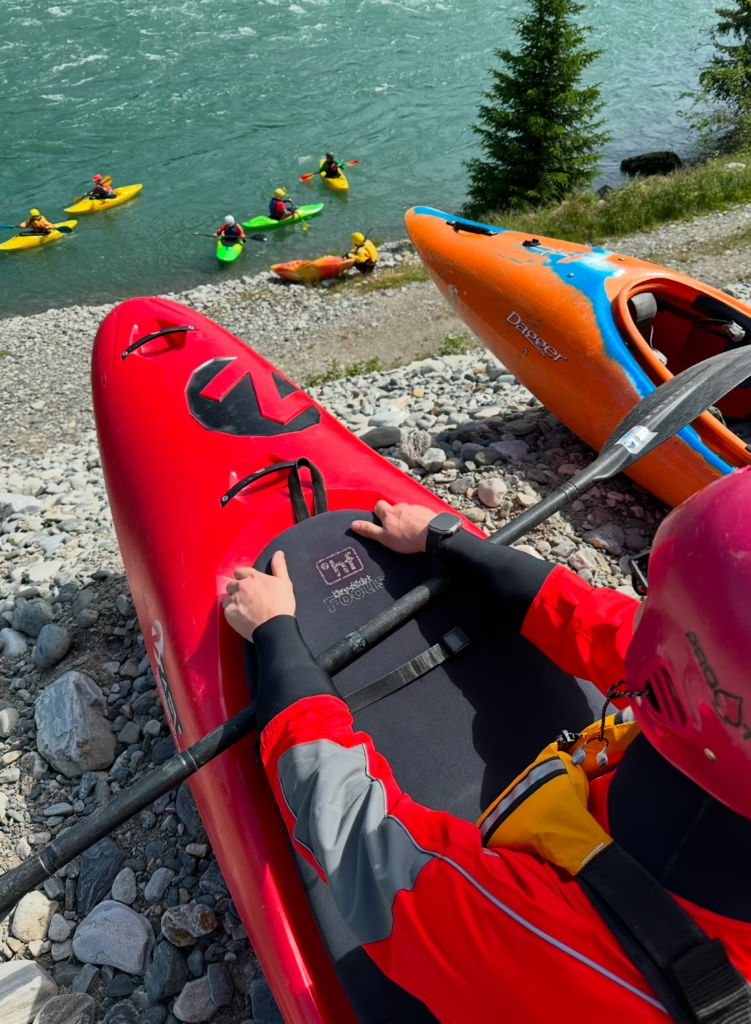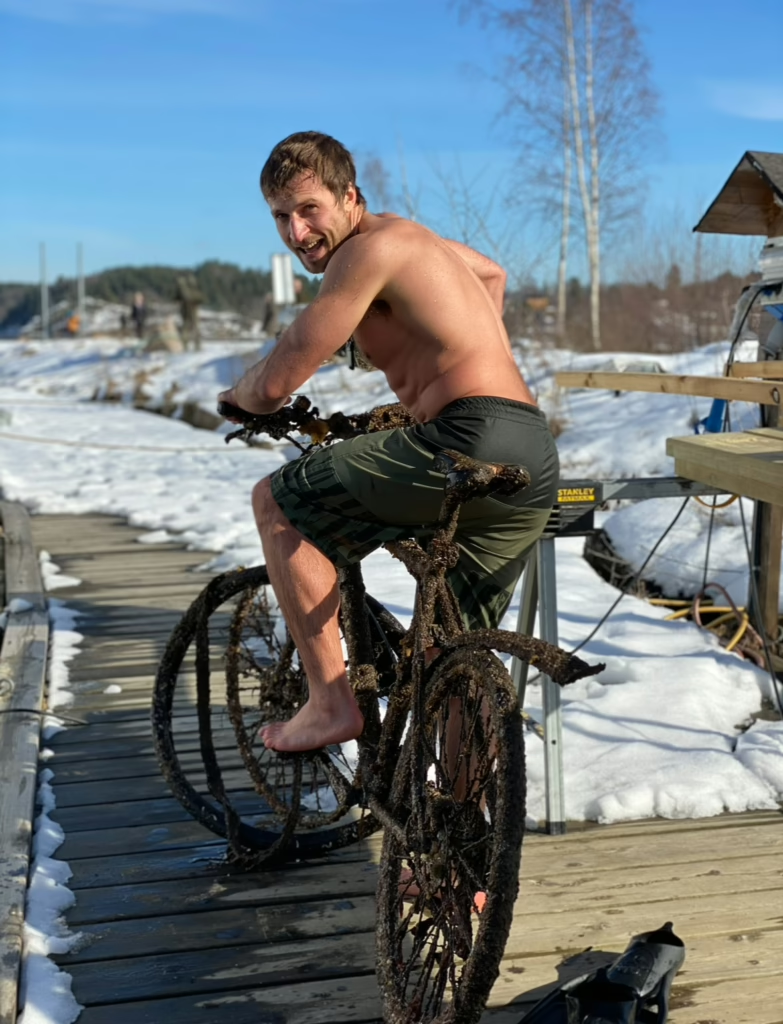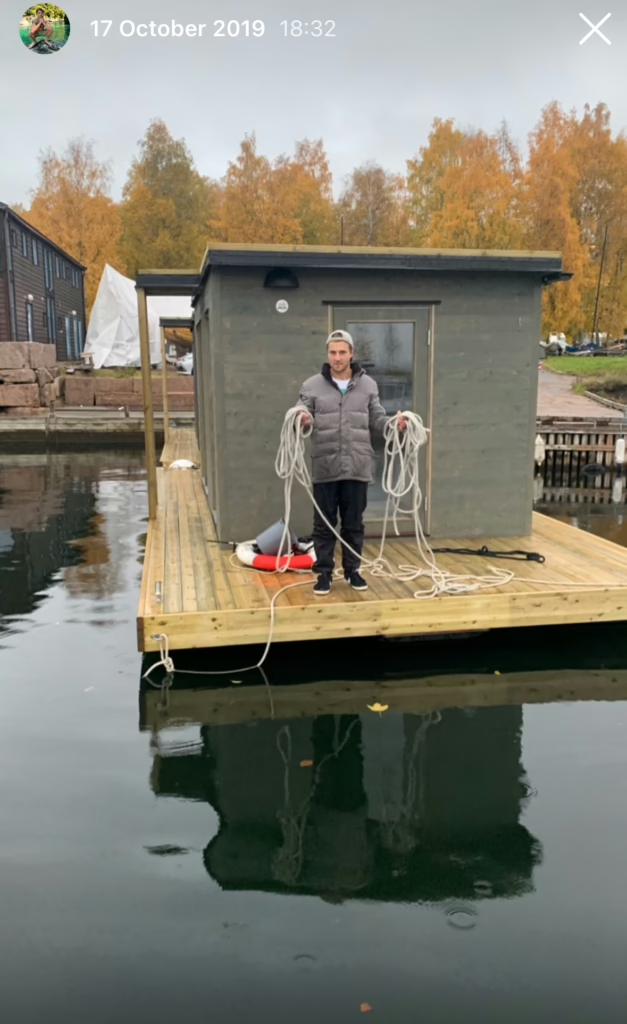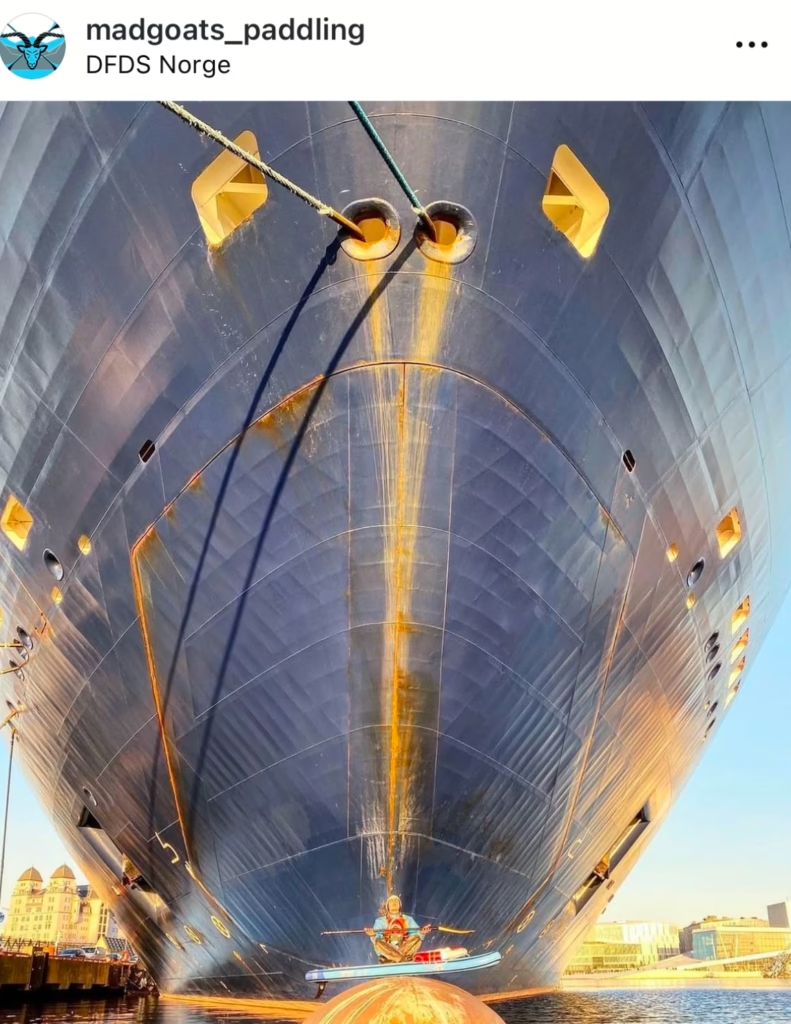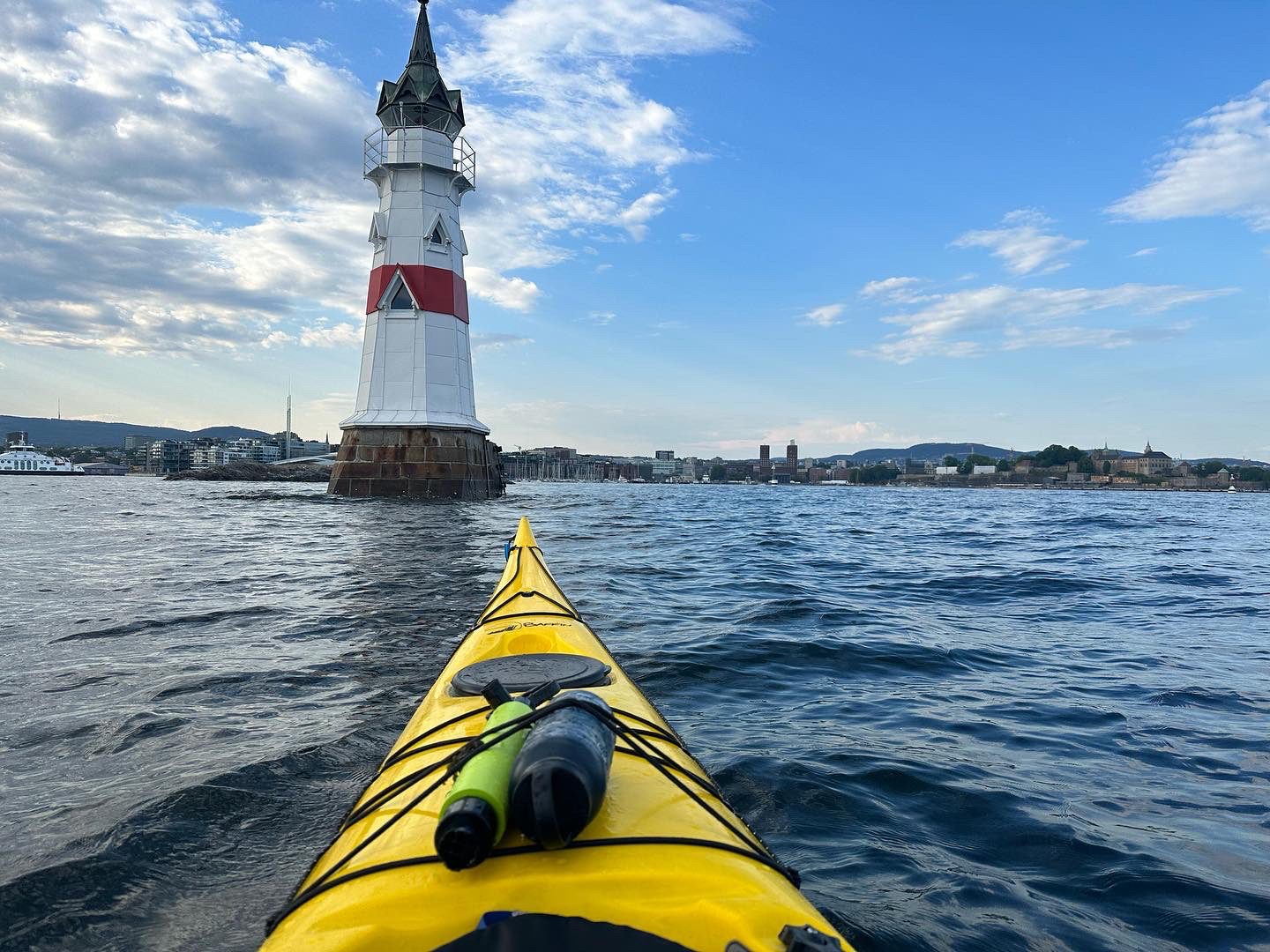An epic quest spanning the globe, from New Zealands craggy peaks to Norways raging rivers – strap in, Goats! A David verse Goliath-like fight, filled with intrigue, amazing partnerships, copious amounts of bureaucracy, and incredible achievements, despite fighting the uphill battle against the inertia of the establishment. A tale of grit, tenacity and a fun-loving attitude that makes it all worth the while!
– “Tomas Lars Hansson, The Goat of Oslo”
1. From New Zealand Shores to Nordic Streams: Tomas Hansson’s Early Journey
Tomas Hansson was born on November 4th, 1990, in Blenheim, New Zealand, to a Kiwi mother and Swedish father. He spent his early years along the stunning east coast of New Zealand’s South Island, in Gore Bay, and later in Christchurch, the South island’s largest city, just an hour south from Gore Bay. When Tomas was three or four years old, his mother, Elizabeth Cox, became a single parent and lovingly raised him and his older brother Dean on her own. Tomas credits her as the best mother ever, giving him an incredible childhood filled with love, adventure, and opportunities.
Despite his happy upbringing, Tomas’s teenage years were rocky. Like many young people, he struggled with paying attention and generally doing what he was told. This period was marked by difficult experiences in and out of school. These challenges shaped him in profound ways, building resilience and fuelling his drive make something of his life. Even during these tumultuous years, his mother’s unwavering support and love remained a guiding force.
At 15, Tomas left school and started working full-time at a fruit and vegetable store called Growers Direct. Over the next three years, he gained a strong work ethic and began to reflect on his future. At 18, he took a leap and enrolled in a two-year outdoor sports course at the Tai Poutini polytechnic in Greymouth on the West Coast of the South Island. It was here that Tomas discovered his passion for adventure sports, especially kayaking, which would become the cornerstone of his life.
After graduating, he moved to Rotorua in the North Island and trained as a raft guide on the Kaituna River. His adventurous spirit then led him to California (near Sacramento), where he worked as a photo kayaker on the American River. However, this chapter was far from glamorous—he lacked a legitimate work visa, earned just $5 an hour, worked every day instead of going on the kayak adventures he’d planned for, and slept in a tent surrounded by wild turkeys and cougars. One and a half months in, Tomas realised he needed a new plan – off to Sweden it was!
At just 20 years old, with no concrete plan and not wanting to return to New Zealand, he remembered his Swedish roots and took a chance, flying to Copenhagen, then across the straight to Sweden. From there, he showed up (almost) unannounced at his father’s doorstep in Ronneby, a quiet town on Sweden’s southeast coast on the Baltic Sea. While working roofing and painting jobs for his father, Tomas remembered a comment from a Californian kayaker: ‘Dude, Norway is one of the best places in the world for whitewater kayaking.’ This sparked something in him. Curious about the possibilities, he started searching for rafting jobs in Norway, realising it was the perfect next step.
Determined to make it happen, Tomas sent emails to rafting companies across Norway. A reply from GoRafting in Sjoa changed everything—they needed a guide immediately. He bought an old Volvo for 5,000 SEK, packed his bags, and drove the 9-hour journey to Sjoa. It was 2011, the year of the infamous Gudbrandsdalen flood. Roads were littered with debris, and Tomas’s car even lost its exhaust pipe to a rock along the way.
Tomas spent three summer seasons in Sjoa, refining his kayaking skills and falling in love with Norway’s wild rivers. Each winter, he returned to New Zealand, working at Peel Forest on the Rangitata River (where his obsession with Goats and bleating started), in Queenstown on the Shotover River (where he won the Citroen extreme kayak race), and went back to Rotorua to work on the Kaituna River. The constant back-and-forth eventually wore thin. Encouraged by old Swedish friends from Ronneby, Tomas set his sights on Oslo. After earning a forklift license in Malmö (where his Swedish half-sister lives and where he stayed during the course) he moved to Norway’s capital city, ready to build something lasting.
From here, the foundation of Mad Goats was laid—a business born out of resilience, authenticity, adventure, and a deep love for nature.
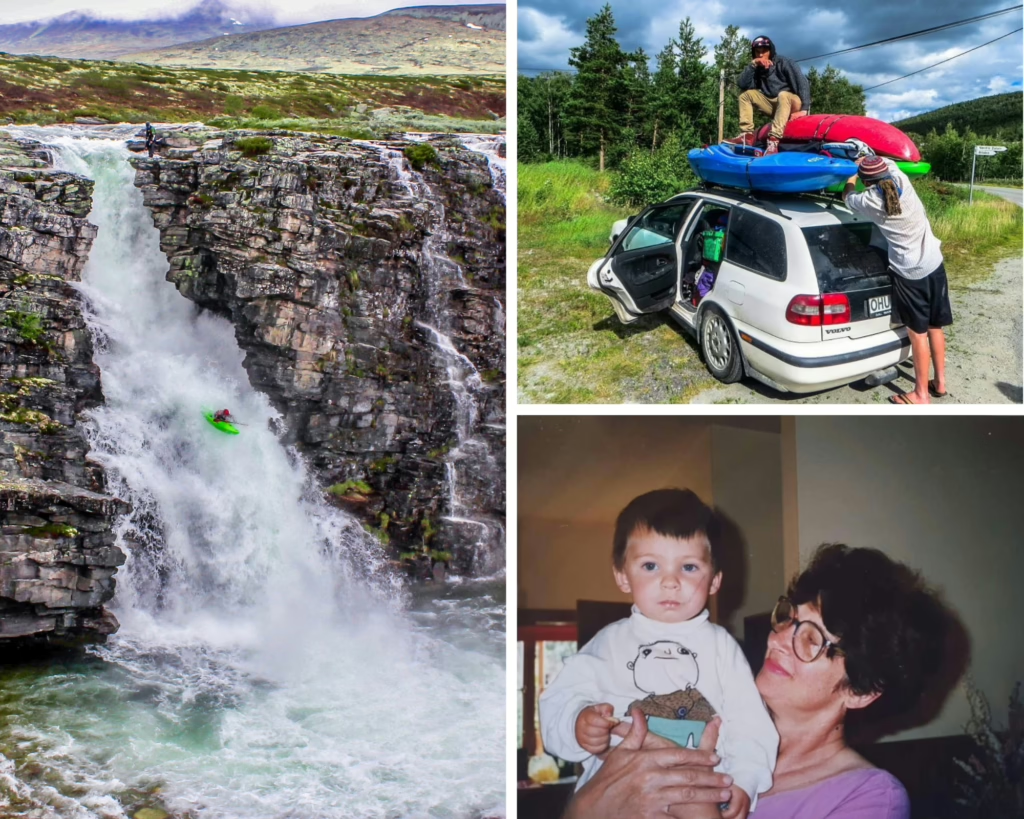
Tomas paddling the Brudeløret waterfall, sitting on top of his volvo and with his Granny Margaret Cox as a baby.
2. From Warehouse Worker to Kayak Entrepreneur: Navigating Oslo’s Waters
After working in a warehouse in Oslo for about a year to save money, Tomas Hansson decided to pursue his dream of starting a kayak company. As a passionate whitewater kayaker, his initial goal was to focus exclusively on teaching river kayaking, the activity he loved most. However, his first lesson in business was that personal passion doesn’t always align with market demand. With few signups for river kayaking, Tomas realized that sea kayaking had a much broader appeal and decided to expand his offerings. When trying to decide on a name for the company, Tomas was sure he would not call it “Mad Goats”, but after a week of not being able to think up any better names, there turned out to be no other choice.
This shift coincided with the creation of the now-famous Akerselva Kayak Tour – which Mad Goats were the first to start. As a whitewater kayaker, Tomas saw every river as a potential adventure. After scouting and paddling the Akerselva from top to bottom, he identified the lower section, starting at Nedre Foss Gård, as the perfect route for a guided tour. At the time, Tomas didn’t own any kayaks, so he rented gear from the OSI student club—an eclectic mix of old, unstable whitewater kayaks. Each trip required him to drive his old van to Sognsvann, descend into a musty world war two bunker/basement to collect the kayaks, and load them onto a trailer he’d bought with his savings and mothers support.
With the rest of his money, Tomas purchased 10 sea kayaks and began offering Våttkort courses (Norwegian kayaking certification) out of his girlfriend’s grandfather’s garage. These courses, along with the Akerselva tours, marked the beginning of Mad Goats as a business. Back then, Bjørvika was a very different place. The Munch Museum didn’t exist yet, and Sukkerbiten/Opera House Beach was a raw, gritty area characterised by gravel banks and the iconic white container buildings that served as an event venue. Sukkerbiten earned its nickname “the sugar cube” from these containers. Sadly, while the rest of Bjørvika has transformed into a majestic modern waterfront, Sukkerbiten remains undeveloped to this day. In fact, it is even less developed now, with the removal of the event area and its famous containers.
During this time, Hav Eiendom (a government owned private commercial property company) granted Tomas a parking permit at the Oslo Opera House Beach, allowing him to park his van and trailer while teaching Våttkort courses. This support was a game-changer, providing a reliable base for his growing operations.
Despite the progress, Tomas was not yet able to pay himself through Mad Goats. To support himself, he worked part-time at the Harald Møller car warehouse in Lillestrøm. Balancing both jobs was challenging, but his passion kept him motivated.
It was during the early days of guiding the Akerselva Kayak Tours that Tomas noticed the significant amount of trash polluting the river. Disturbed by the environmental impact, he began picking up litter during the tours. This small initiative resonated with participants and gradually evolved into a larger movement. Years later, this effort blossomed into Fjord CleanUP, an incredible organisation dedicated to cleaning Oslo’s waterways and promoting environmental stewardship – you can join them and the fight against marine pollution in Oslo here.
By 2016, at just 24 years old, Tomas had laid the foundations for what Mad Goats would become. The Akerselva Love Story was no longer just a whitewater kayaker’s dream but a key chapter in the journey of Mad Goats, with tours and courses becoming an integral part of Oslo’s outdoor scene.

Tomas when first starting exploring and guiding the Akerselva Kayak Tour, teaching early Våttkort courses in Bjørvika and parking van and trailer by the Oslo Opera House beach.
3. Hav Eiendom – Kayak Base Dilemmas
After just one year of operations, Mad Goats achieved a significant milestone: securing a permit from Hav Eiendom to place a kayak container beside the Opera House Beach. This development was a game-changer, eliminating the need to drive kayaks into town for every course or tour. The convenience and stability this brought allowed Mad Goats to grow, and the arrangement was initially set to last four years. However, just one year later, Hav Eiendom reversed their decision and asked Mad Goats to remove the container.
This abrupt decision was heart-wrenching. Forced to relocate, Mad Goats found a temporary solution by storing kayaks on a farm outside of the city, a 30-minute drive from Oslo. The result was a logistical nightmare—constant trips in and out of the city, often in rush hour traffic. What made this even harder to swallow was that the spot vacated by the container remained unused for years, highlighting the unnecessary nature of the disruption. This marked Mad Goats’ first encounter with what they came to call the “fjord power games,” where bureaucratic decisions seemed to undermine Oslo Kommune’s own goals, particularly the Fjord Byen initiative, which Mad Goats actively supported.
The challenges didn’t stop there. Once the container was gone, Hav Eiendom also revoked Mad Goats’ parking permits at the Opera House Beach. This compounded the difficulty of running courses and tours, prompting Mad Goats to take action. Despite limited resources, they hired a consulting agency Byrå Tusj to create a professional presentation arguing for a permanent fjord base in Bjørvika. The vision was to establish a stable outdoor activity hub that would contribute to the area’s growth and offer the best possible service to customers.
The result was a beautifully crafted proposal, but Hav Eiendom’s response was a firm and resounding “no.” The rejection was disappointing, but Mad Goats refused to let it define their future. True to their name, the Goats persisted, determined to find a solution and keep their vision alive.

Goats still showing people a good time on the river, first slide of presentation to get a permit for a paddling base in Bjørvika from Hav Eiendom, trailer and kayaks now out at a farm in Slattum.
You can download Mad Goats Presentation they tried to convince Hav Eiendom with here:
4. The Goat Raft & River Woes
Despite facing significant challenges, Mad Goats continued to grow, providing hundreds, if not thousands, of people with unforgettable experiences on both the Akerselva River Tour and the Oslofjord. After being refused a permanent location by Hav Eiendom, an opportunity arose with Oslo Badstuforening, then known as SBHA, who had just secured permits for their renowned sauna, “Skarven.” Sharing a common vision of making Oslo’s waterways accessible through healthy, sustainable, and affordable activities, we approached them with a request to store some kayaks at their location—ironically, the same spot where our container had previously stood. They graciously agreed, allowing us to construct a makeshift kayak storage at the Oslo Opera House Beach.
However, this arrangement was short-lived. Hav Eiendom discovered our setup and reprimanded Oslo Badstuforening, demanding that they remove our kayaks immediately. This was perplexing, as the area remained an unused gravel wasteland. Faced with this setback, we realised that if we couldn’t secure a base on land, we would have to take to the fjord.
Thus, the infamous Goat Raft was born. We built a raft, equipped it with a kayak rack, and stationed it at Langkaia, in front of the Opera House.
Shortly after deploying the Goat Raft, Bymiljøetaten – Oslo Kommune convened a meeting with all fjord operators to discuss activating the Oslofjord in line with their Fjordbyen mandate. To our surprise, the Goat Raft featured prominently on the front page of their presentation as a shining example of how to achieve Fjordbyen’s objectives. Yet, in a twist of irony, they later instructed us to remove the raft, contradicting their own mandate and presentation.
Concurrently, Hav Eiendom attempted to prohibit Mad Goats from operating on the Akerselva River, alleging to the Oslo Fire Department (who in Norway is also responsible for water accidents) that we were “risking drowning people.” The underlying issue seemed to be their sense of ownership over the river and the ongoing movement of construction equipment across it for the Munch Bridge and Munch Museum projects. While we acknowledged the potential dangers, we believed that collaborative solutions were possible and it should not stop the ability for 1000s to enjoy the wonderful Akerselva River. Thankfully, the Oslo Fire Department did not share Hav Eiendom’s concerns. They recognized that kayaking on the Akerselva is safest when done through guided tours with professional guides and proper safety equipment. Justice, rational thought, and fairness prevailed—thank you, Oslo Fire Department.
These experiences illuminated the complexities of operating on the fjord, revealing a tangled web of politics, power dynamics, and self-sabotaging bureaucracy. It became clear that navigating these waters required not only resilience but also a keen understanding of the intricate landscape we were operating within.

We started a kayak and sauna combination trip when Oslo Badstuforening (the SBHA) appeared on the scene. The infamous Goat Raft being built and lifted onto the water at Lysaker, and a photo of Mad Goats and Oslo Badstuforenings joint activities back in the day.
Chapter 5: Fjord Alliance and Sukkerbiten
In 2017, as Mad Goats established the Goat Raft and collaborated with Oslo Badstuforening, Hans Jørgen’s Oslo Fjord Hage (Oslo Floating Garden Dome) emerged at Langkaia, enhancing the area’s vibrancy. However, structural issues arose when the flotation barrels began imploding, leading Oslo Havn to relocate the garden to Sukkerbiten. There, the Floating Garden transformed into a central hub for fjord activity providers, including Fjord CleanUP, Mad Goats, Oslo Badstuforening, Akerselva Padleklubb (co-founded by Tomas Hansson) and Akerselva Trebåtforening.
Recognizing the challenges each organization faced, it became evident that a unified approach was necessary. Gathering at Hans Jørgen’s Floating Garden, we envisioned creating a Fjord Activity Hub to offer exceptional services, connecting residents and visitors to the Oslofjord. This initiative aimed to provide stability and security, free from disruptions by influential entities with differing visions for fjord utilisation. The name of this conglomeration of fjord actors was the be called “The Fjord Alliance”!
Unfortunately, our collective efforts did not materialize into a concrete plan, leading to fragmented endeavors and diminished strength for all parties. For instance, Hans Jørgen, who had permits for the Floating Garden dome, initially allowed us to park the Akerselva and sea kayak course trailer behind the Dome during activities. However, upon Hav Eiendom discovering this arrangement, they reprimanded him, prompting him to rescind the parking permission to avoid jeopardising his own position.
Had we united against organisations like Hav Eiendom, we might have demonstrated the value of our passionate fjord collective to Oslo, securing a dedicated space for safe and sustainable operations.

Instagram Post from when we were trying to materialise the Fjord Alliance Group. The Floating Oslo Garden Dome being craned onto the water at Grønlikaia, and Hans Jorgen himself at the Dome.
Chapter 6: Saunas in Aker Brygge
During this period, Tomas was approached by a Danish electric boat rental company GoBoat, who wanted to set up their boat rental service in Oslo – Tomas went above and beyond to help them but it never eventuated into anything. Despite his limited boating experience, he was enthusiastic about promoting a cleaner and quieter fjord environment so decided to collaborate with the Norwegian company Greenwaves, and together they developed the concept of GreenBoats, aiming to retrofit old boats with electric propulsion systems for rental purposes. The vision was to reduce the prevalence of private motorboats on the Oslofjord, which occupy significant storage space and contribute to noise, safety concerns, and pollution. By offering sustainable boating alternatives, they sought to preserve the joys of boat life while mitigating environmental impacts.
Securing a location at Aker Brygge through Norwegian Property (NPRO), GreenBoats became Oslo’s first electric boat rental service. This initiative paved the way for subsequent companies like Kruser and Skipperi to establish similar services. Notably, Tomas facilitated Kruser’s introduction to Aker Brygge, leading to the establishment of the current electric boat dock—a testament to his role as a catalyst for positive change.
With the dock in place and winter approaching, Tomas, an avid user of the saunas in Bjørvika, proposed the installation of saunas at Aker Brygge. Receiving approval from NPRO, this led to the creation of Oslo Fjord Spa, marking the beginning of Mad Goats’ sauna ventures in Aker Brygge. Concurrently, Tomas observed significant water pollution around Aker Brygge and Tjuvholmen. Embodying the Goat spirit, he initiated cleanup efforts, culminating in the well-known Fjord CleanUP events, which combined cleaning followed by a free sauna and food, together. It was also during the Aker Brygge period that Fjord implemented the first sugar kelp restoration project on the Inner Oslofjord together with Sea Weed Solutions based in Trondheim which resulted in growing a lush seaweed garden under the saunas, and which kicked started other organisations like Marin Reparatorene and Marea Oslo to also start seaweed projects of their own.
These years at Aker Brygge were marked by diverse offerings, including kayaking, stand-up paddleboarding (SUP), fjord cleanups, and sauna sessions. The community thrived, even amidst the challenges posed by the COVID-19 pandemic. When the Russian invasion of Ukraine started we donated 10% of the sauna income to the Ukraine defence (Save Life Ukraine) which ended up totalling over 200.000NOK, which was a huge sum for our small business and money we really did not have to spare. However, tensions arose when NPRO sought to claim full credit for the cleanup efforts, publishing content on their Aker Brygge page (now removed of course) that omitted acknowledgment of Fjord CleanUP’s contributions. A meeting with NPRO regarding sponsorship ensued, during which they proposed a 20,000 NOK contribution—30,000 NOK less than Fjord CleanUP’s minimum sponsorship threshold—in exchange for the rights to include the cleanup statistics in their annual corporate environmental report. Tomas declined, emphasizing the importance of genuine support and integrity. In response, NPRO terminated Mad Goats’ presence at Aker Brygge, leading to the dissolution of the community, cessation of cleanup activities, and discontinuation of paddling programs. This decision, driven by corporate power dynamics and greenwashing attempts, ultimately hindered efforts to enhance Oslo’s environment and societal well-being. In the aftermath, KOK Oslo was permitted to occupy the space, offering premium floating sauna experiences without the community-focused initiatives of cleaning, paddling, or free events.
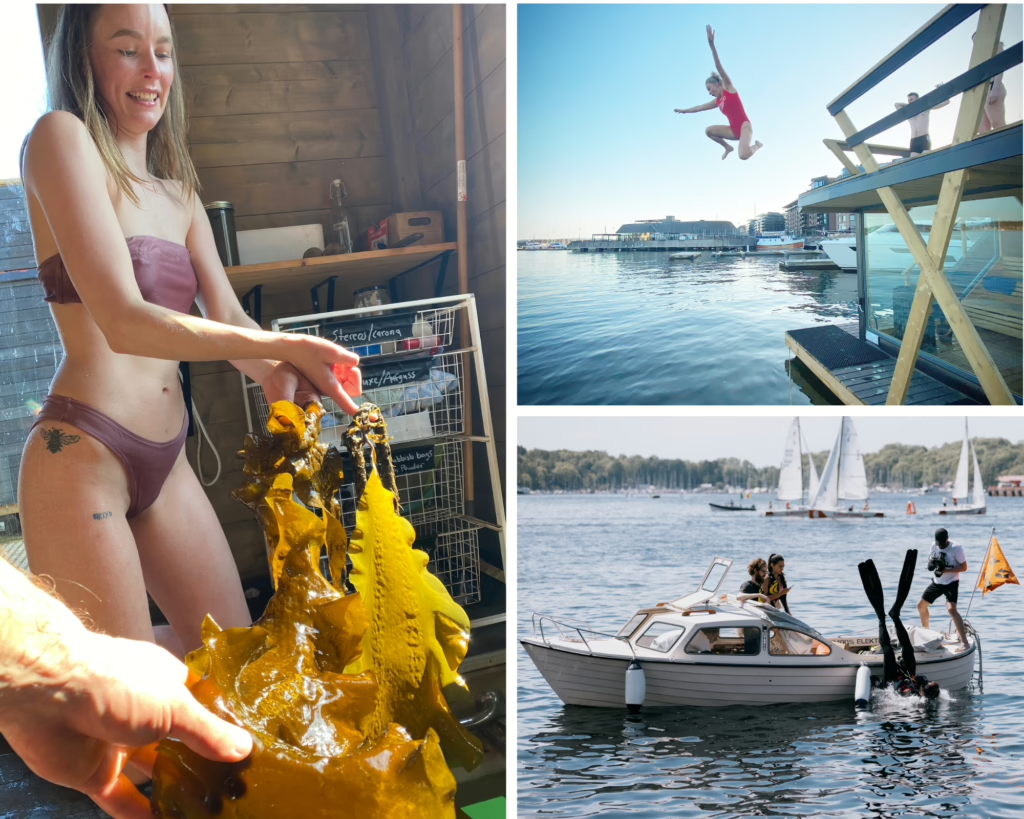
Anoushka Nordby (Tomas’ amazing other half) holding the famous McWeed Sugar Kelp leaf which was sent up to the Seaweed solutions lab. Ingvild jumping from Freya the sauna into the Oslofjord and Fjord using the GreenBoats electric boat to place artificial lobster houses in Bjørvika).
7. Adrift at Sea and Nowhere to Go: Moss, Tønsberg, and Selvaag Eiendom (Tjuvholmen) to the Rescue
It was a time of great upheaval—a period we now refer to as “The Great Displacement.” With our saunas scattered and our community in flux, the Goats faced one of their toughest challenges. But true to the indomitable Goat spirit, we pressed forward, refusing to let setbacks define us.
We sold one of our saunas to our steadfast allies at the Oslo Sjøskole on Hovedøya, knowing it would find a good home there. Another sauna was moved to Langkaia, and the now-famous “Freya” was towed to Moss (huge thank you to Eivind from Fjordtokt who towed us to Moss in his boat), where we attempted to establish a new base. Meanwhile, one of our beloved saunas Huginn made its way to Tønsberg to test new waters and the other we moved to where the Goat Raft was in front of the Oslo Opera House. This marked a bold but ultimately bittersweet chapter, as neither Moss nor Tønsberg became the sanctuary we had hoped for.
But not all was bleak. Through it all, Mad Goats remained steadfast in our mission to connect people to Oslo’s waterways, taking thousands of adventurers kayaking on the Akerselva and Oslofjord. Laughter, joy, and unforgettable memories kept our spirits high even in the stormiest seas.
Amidst this turbulence, a competition was announced by Bymiljøetaten, offering activity providers the chance to secure prime locations along Langkaia. The criteria were clear: the chosen applicants should offer diverse activities, benefit the environment, connect people to the fjord, and be suitable for kids. Together with Kruser, Akerselva Padleklubb, and FjordCleanUP, we submitted the most diverse and comprehensive application. To our surprise, Bymiljøetaten ignored their own criteria and awarded permits to three sauna companies: Salt Art Music, KOK Oslo, and Oslo Badstuforening. This decision felt like a betrayal—not just of the application process but of Oslo’s commitment to fair governance and supporting meaningful fjord activities. When you ask for diversity in services it makes no sense to then choose 3 companies who all offer the same thing – sauna, sauna and sauna.
The situation grew more frustrating when we were told to move the Goat Raft or face fines. With no location available, we hid the raft beneath Sørenga for two years—a quiet act of rebellion against the very system that had once celebrated the raft as a shining example of their Fjordbyen vision. Ironically, Bymiljøetaten needed the space for a new project, “Oslo LOA,” spearheaded by Nordic Ocean Watch. While the concept was admirable, Fjord CleanUP later collaborated with LOA to provide trash for their events, exposing the project’s underuse. Tragically, the LOA raft sat idle for nearly two years, costing taxpayers hundreds of thousands of kroner while becoming a shelter for homeless individuals and drug addicts. Fjord CleanUP is now working hard with Bymiljøtaten to take over its administration so it can finally achieve what it was built for – be an active hub showcasing and spreading awareness about the marine pollution problems we face and encourage and engage industry leaders, after seeing all their products ending up in Oslofjord, to change their ways.
This was a bitter pill to swallow. The Goat Raft, which could have been used by Oslo’s residents throughout this time, had been forced out. But as every Goat knows, adversity is just another hill to climb. The Goat Raft lives on—though it’s now in disguise. Free kayak tour for the first person who discovers where it’s hiding! 🐐
Amidst these challenges, a ray of hope emerged: we purchased the Sjoa Kajakk Senter from Anett, a full-circle moment for Tomas, who had started his paddling journey as a young raft guide in Sjoa with GoRafting. This wasn’t just an acquisition; it was a homecoming. Today, Mad Goats has expanded the Sjoa Kajakk Senter, acquiring land down to the river, leveling it, and building a cabin, sauna, and hot tub—a haven for paddlers seeking to connect with Norway’s wild rivers. We are so stoked to continue on Anetts amazing whitewater legacy in Sjoa.
Back in Oslo, we brought the sauna from Tønsberg back to reunite with its counterpart at the Oslo Fjord Sauna, operated by Fjord CleanUP. These two saunas—Huginn and Muninn—stood side by side once again, symbolising resilience and unity. Selling the saunas to Fjord CleanUP, even at a significant financial loss, gave them a vital resource: a community hub where members could warm up, train, and gather for restoration efforts. Their sauna operations honoured the OG floating sauna “Måken,” built from scrap wood after the Øya Festival by the original founders of Oslo Badstuforening. See where Oslo Fjord Sauna is located in Bjørvika here.
Before leaving Aker Brygge, we had formed a promising relationship with Selvaag Eiendom, who became one of Fjord CleanUP’s first sponsors. Their early support enabled us to purchase our first proper free-diving suits—a massive upgrade from the makeshift kayak wetsuits and drysuits we’d relied on. This small but critical act of generosity planted the seeds for future collaborations. They also allowed us to move our kayak and SUP operation from Aker Brygge over to their area.
Selvaag Eiendom’s support was nothing short of lifesaving during this time of transition. Thanks to their belief in our mission, Mad Goats continues to connect people to the fjord, proving that even in the face of adversity, the Goat spirit endures. The story is far from over, and together, we are building a legacy worth paddling for – maaaeeeehhh!!!

The famous OG Goat raft beside the Opera House that when placed there was used for kayak rentals, tours and courses and shared with Akerselva Padleklubb (co-founded by Tomas). Tomas taking over ownership from Anett of the Sjoa Kajakksenter. Eivind from Fjord Tokt towing Freya in his very unsuitable boat to Moss – this guy is such a legend.
8. Happy Days and the Rise of Fjord CleanUP
For two beautiful years, the Goats found a home—a true sanctuary—at Mad Goats Tjuvholmen. Here, amidst the shimmering waters and iconic skyline of Oslo, we built something special: a floating sauna community that radiated warmth, health, and connection. The spirit of these saunas wasn’t just in their heat; it was in the friendships forged, the laughter shared, and the unique blend of tranquility and adventure they offered.
Selvaag Eiendom saw the potential in our vision. They allowed us to launch kayak and SUP activities at Tjuvholmen, laying the groundwork for something even greater. Soon, one floating sauna from Ute Sauna appeared, followed by a second. Then, with the tides turning, we brought “Freya” back to Oslo from Moss to complete the trio at Tjuvholmen. We also transformed our kayak and SUP raft into a fully equipped base, complete with a warm changing area, lighting, and a reception to welcome guests. It was a sanctuary of Goat spirit—a beacon of community, sustainability, and adventure.
Our saunas became a haven for Tjuvholmen and Aker Brygge residents and workers alike. With one of Oslo’s most affordable memberships—just 500 NOK for unlimited sauna use—people came to sweat away stress before or after their workdays. Partnerships bloomed with local businesses like The Thief Hotel, Døgnvill Burger, and Åpent Bakeri, creating a network of support and collaboration. Even better, we combined sea kayaking tours with sauna sessions, turning each guided paddle into a full-blown fjord adventure.
This was a golden era for the Goats. After years of being uprooted and pushed out, we finally felt safe. We could settle in, invest in our community, and dream big. No longer was our energy spent fighting for a foothold—we could now focus on what we did best: providing unforgettable experiences, fostering connections, and inspiring people to care for the fjord.
Meanwhile, across the water at Sørenga, Fjord CleanUP was hitting its stride. With two saunas of their own, on-land containers to store cleaning gear, and a steadily growing membership, their impact on Oslo’s waterways was growing by the day. Together, we were making waves—cleaning the fjord, spreading joy, and proving that collaboration and determination could create something extraordinary.
This time wasn’t just about business—it was about belonging. We had built a vibrant, supportive community of people who shared our values: health, sustainability, and a deep respect for the fjord. These were happy days, filled with purpose and possibility. We were not just surviving; we were thriving, one bleat, one paddle stroke, one sauna session, and one fjord cleanup at a time.

Kayaking and Sauna in full swing at Mad Goats Tjuvholmen. Anoushka with a happy kayak-smile while out paddling on Oslofjord. A happy group on the roof of Freya drinking Kombucha from Empress Kombucha – as Mad Goats had just become Oslo’s first non-alcoholic floating sauna.
9. Here We Go Again: An Uncertain Future in Tjuvholmen
Just as the Goats had found their footing, offering serene floating sauna experiences and fostering a vibrant community at Tjuvholmen, unforeseen challenges emerged. In June 2024, following complaints from local residents, the Planning and Building Agency (Plan og Bygg, PBE) warned Mad Goats that they were in an “unregulated zone” and needed to apply for a dispensation or we would have to close. We tried our best to hand in the right documentation in the short time we were given, during the most inconvenient time (Norwegian Summer Holidays), but were eventually ordered to close on the 02nd of September until we handed in a complete application. Because the application is very complex we needed to hire architects (White Architects; whom are really amazing) to do the application on our behalf, costing over 250.000NOK and had to employ a lawyer from Tveter & Kløvfjell (to protect us from any other unfair treatment that might come our way). As of now 29th of November 2024, we have handed in the full application and are waiting for Plan Og Bygg to decide on the case. Because Oslo Kommune and Oslo Havn both have a mandate and commitment to create Fjord Byen (Fjord City) we are positive about the result.
Follow the Public Case here on PBE’s://innsyn.pbe.oslo.kommune.no/saksinnsyn/casedet.asp?direct=Y&mode=&caseno=202458483.
It should be made clear that Per Arne Damm was one of the main instigators in closing Mad Goats and Fjord CleanUP in Tjuvholmen down. Here is some more information about this character.
Per Arne Damm, a lawyer and resident of Tjuvholmen, has been a central figure in controversies regarding local business operations and public access to the Oslofjord. Damm gained significant attention for his role in initiating the closure of Mad Goats’ sauna operations at Tjuvholmen. His complaints, alongside those of other local residents, raised concerns about noise, smoke, and safety issues from the sauna activities. This led to formal objections influencing Oslo Havn and Plan- og Bygningsetaten (PBE) to deny permits for the continuation of Mad Goats’ offerings (Avisa Oslo, Avisa Oslo).
This decision has been criticized for its broader implications, including reducing public access to the fjord, disrupting community engagement, and hindering environmental work, such as the Fjord CleanUP initiative. Critics argue that such actions prioritize private interests over public benefits and environmental sustainability (Avisa Oslo).
Beyond his involvement at Tjuvholmen, Damm has faced legal scrutiny in a separate high-profile case involving the bankruptcy of the hotel chain Maribel. Though initially acquitted, Økokrim (the Norwegian National Authority for Investigation and Prosecution of Economic and Environmental Crime) has appealed the ruling, keeping him under investigation for alleged financial misconduct (Finansavisen, AdvokatWatch).
Damm’s role in these issues highlights broader systemic challenges in balancing private and public interests in Oslo’s waterfront areas. His actions and their consequences have sparked debates about how the city manages access, community initiatives, and environmental sustainability along the fjord. For this reason we think it is important that there is a digital record for the public to see how damaging Per Arne Damms complaints were, and that he definitely has not left Oslo a better place – this is shameful legacy for someone to leave a city and its people. Read our email about his complaints when they first came out here.
Moving on…
This closure reverberated beyond our immediate operations. Our partners at Fjord CleanUP lost a vital space to warm up after their tireless efforts cleaning the fjord in the Tjuvholmen area. The synergy between our organisations had been a cornerstone of community engagement and environmental stewardship, now abruptly halted.
In response, we initiated a signature campaign to demonstrate public support for our cause. Amazingly, we garnered over 300 signatures (The required amount to get a hearing at local government) in less than 24 hours, a testament to the community’s appreciation and desire for our services.
Check out the signature campaign here: Minsak
This overwhelming support has been a beacon of hope during these uncertain times.
We remain optimistic that PBE will recognize the value we bring and grant the necessary permits. Our partnership with Selvaag Eiendom has been instrumental in our journey, and we sincerely hope they continue to support our mission. The prospect of a permanent shutdown is disheartening, not just for us but for the community we serve and the good positive impact we have on Oslo’s environment and health.
It’s essential to understand that we are not a destructive force: we do not pump pollution into the waterways like big industry, we do not sell junk food or cigarettes & harm peoples health, we do not partake in criminality selling drugs to youth or engaging in violence, or work towards the privatisation of publicly owned areas. We are a small kayak and sauna company, nothing more and nothing less. Our goal has always been to provide affordable access to the fjord through healthy, fun, community-based, and sustainable activities. While corporate Oslo may have found it challenging to navigate the unconventional communication style of a young Kiwi, his dedication to the city’s well-being is unwavering. Tomas Hansson, our founder, is a formidable force for good, driven by a genuine love for Oslo and its people. He should be supported by the politicians and business leaders – not chased around, discriminated against, and squeezed and ostracised, until he has nothing left to give this city.
As we face this crossroads, we remain committed to our mission and hopeful for a resolution that allows us to continue serving the Oslo community. Whatever happens, we are Goats, and we live by the adage: “Never give up, never surrender.” We are not going anywhere and will continue to provide joy and happiness on the waters of Oslo and Sjoa.
“Catch you on the water! ❤️🐐”
“Chapter 10 is yet to be written, but we are sure it will be one filled with positive news and victory!”
In the meantime check out these photos spanning 10 years of Goaty Shenanigans and goods times on Akerselva and the Oslofjord waterfront (now see below after Chapter 10).
Chapter 10: We Lost the Battle but Not the War
In the final month of 2024, Mad Goats AS faced its most significant challenge to date. Despite years of safe operations and community-building, both Oslo Havn and Plan- og Bygningsetaten (PBE) denied our applications to continue activities at Tjuvholmen. This decision wasn’t just a setback for our company; it contradicted Oslo Kommune’s Fjordbyen mandate, which promises increased public access and sustainable development along the Oslofjord waterfront – instead they chose to keep the area private and prioritise accident-prone private boats which are also a huge contributor to marine pollution on Oslofjord.
The Verdict That Made No Sense
The verdict from Oslo Havn and PBE claimed that “the risks outweigh the benefits” of our activities at Tjuvholmen. However, this assessment was unsupported by evidence. Over a decade of operations, we’ve safely taken thousands of people kayaking annually without incident, and our staff includes certified lifeguards and experienced outdoor guides. Meanwhile, the only serious accident on the Oslofjord in 2024 involved a collision between a cabin cruiser and a sailboat—nothing to do with swimming, kayaking, or SUP activities.
Adding to the inconsistency, Oslo Havn itself actively promoted our kayaking, SUP, and sauna activities during the Havnelangs festival earlier in the year. How can a government agency endorse our activities in public events while simultaneously refusing to support them in official decisions? See evidence of Oslo Havn promoting our sauna and paddling acivities as part of their annual Havnelangs festival here in our official appeal email.
The Discrimination Is Clear
Mad Goats was not just running saunas; we offered comprehensive recreational and environmental initiatives. Our paddling tours, including the popular “Oslo Fjord Kayak Tour,” Våttkort kayak certification courses, and SUP rentals, enriched public access to Oslo’s waterfront. Yet, we were singled out for closure while other operators—like KOK, Oslo Badstuforening at Sukkerbiten, and Kongen Marina—continue to operate in unregulated swimming zones without offering similar environmental or community benefits. You can read more about how other saunas are allowed to operate in unregulated swimming areas when we are not, here.
Environmental and Community Contributions
Mad Goats’ activities were not limited to recreation. We collaborated with Fjord CleanUP to restore the fjord’s ecosystem, including installing seaweed restoration projects beneath our floating platforms and organizing regular cleanup events. These efforts directly supported the Fjordbyen vision of a clean, accessible, and sustainable fjord. The closure of our operations not only dismantles these initiatives but also prioritizes private boat traffic—known for pollution and safety risks—over public health and environmental sustainability.
Systemic Problems in Bureaucracy
The decision reflects a broader systemic failure within Oslo’s government and bureaucracy. While individuals like Edvard Bondi Knowles (edvard.knowles@pbe.oslo.kommune.no) at PBE and Rune Aarset (rune.aarset@oslohavn.no) at Oslo Havn are responsible for implementing policies, their decisions demonstrate a lack of accountability and alignment with their organizations’ stated goals. This is not just a failure of individuals but evidence of a dysfunctional system that prioritizes privatization and short-term convenience over long-term public and environmental benefit.
Public Outcry and Support
The public disagrees. Within 24 hours, our campaign to save Mad Goats garnered over 300 signatures on the official platform minsak.no, far exceeding the required threshold to bring the issue to the city’s attention. This overwhelming support reflects Oslo residents’ frustration with the prioritization of private interests over public accessibility.
Moving Forward: Resilience in the Face of Adversity
Mad Goats is not defeated. This setback has only strengthened our resolve to fight for public access, sustainability, and the community we’ve built. While we can no longer operate at Tjuvholmen, we are proud to announce the expansion of our activities to Sjoa, where we’ve acquired new land to offer whitewater rafting in 2025. This chapter has taught us invaluable lessons about resilience, adaptability, and the need to challenge broken systems.
To learn more about our journey and join us in advocating for a better future, explore the case files here or view the official map of the site here. Stay informed and engaged with our history and mission here.
Lastly, and if anyone is interested in the debate about private-public ownership, we can recommend this study by Jonny Aspen: An urban researcher and co-author of studies on Oslo’s waterfront development, Aspen has critically analyzed the implications of privatizing public spaces in a Nordic context – you can read his study here.
